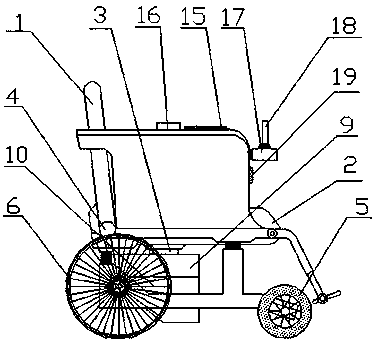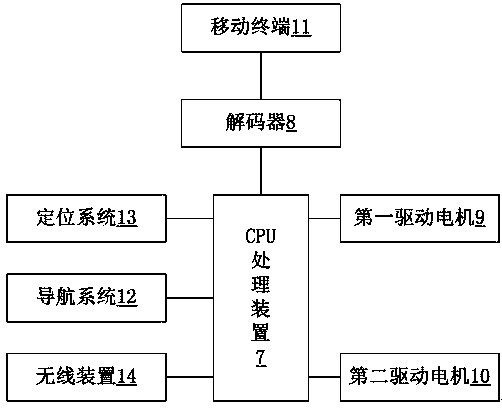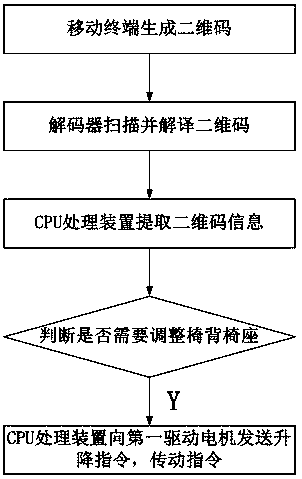Intelligent sharing wheelchair based on two-dimensional code
A technology of two-dimensional codes and wheelchairs, which can be used in patient chairs or special transportation tools, vehicle ambulance, medical transportation, etc. It can solve problems such as difficult operation and achieve superior performance.
- Summary
- Abstract
- Description
- Claims
- Application Information
AI Technical Summary
Problems solved by technology
Method used
Image
Examples
Embodiment 1
[0023] The reference picture is Figure 1-4 . An intelligent shared wheelchair system based on a two-dimensional code, including: a vehicle body, a chair back 1, a seat 2, a lifting shaft 3, a transmission 4, a front wheel 5, a rear wheel 6, a CPU processing device 7, a decoder 8, The first driving motor 9, the second driving motor 10, the mobile terminal 11, the decoder 8 is connected with the CPU processing device 7, and the CPU processing device 7 is connected with the first driving motor 9 and the second driving motor respectively. 10, the first driving motor 9 is connected to the seat 2 through the lifting shaft 3, and connected to the seat back 1 through the transmission 4, the seat 2 is pivotally connected to the seat back 1, and the second Drive motor 10 is connected with front wheel 5, rear wheel 6, and described mobile terminal 11 is used for generating two-dimensional code, and described decoder 8 is used for scanning and interpreting described two-dimensional code...
Embodiment 2
[0030] The reference picture is figure 1 . This embodiment is basically consistent with the first embodiment, the difference is that the wheelchair is also provided with a manual adjustment device 15 and a Bluetooth device 16, and the manual adjustment device 15 is used to help users who use the wheelchair for the first time to find a suitable chair. The angle of the back 1 and the height of the seat 2, the CPU processing device 7 will record the angle of the back 1 and the height of the seat 2 according to the user's adjustment, and use the Bluetooth device 16 to transmit the data adjusted by the user to the mobile terminal 11 so that It is convenient for the user to use afterwards.
[0031] Specifically, for users who use the wheelchair for the first time, the manual adjustment device 15 can be used to adjust the chair back 1 and the seat seat 2, and the manual adjustment device 15 has a reset function. After the chair back 1 and the seat seat 2 are returned to their initi...
Embodiment 3
[0033] The reference picture is figure 1 . This embodiment is basically the same as the first embodiment, except that the vehicle body 1 is also provided with a control device 17, which is used to suspend traveling and terminate the traveling process. The control device 17 is also provided with an operating rod 18, and the operating rod 18 is used for the convenience of the user to fine-tune the direction of travel of the intelligent wheelchair.
[0034] The armrest of the car body is also provided with an infrared emitting and sensing device 19, which is used to send a sensing signal to the CPU processing device 7 when an obstacle is sensed, so that the CPU processing device 7 sends a signal to the first The two driving motors 10 send reversing signals to control the front wheels 5 to adjust the direction of travel to avoid obstacles.
[0035] Specifically, when the user encounters a red light or the user needs to temporarily stop while traveling, the control device 17 can b...
PUM
 Login to View More
Login to View More Abstract
Description
Claims
Application Information
 Login to View More
Login to View More - R&D Engineer
- R&D Manager
- IP Professional
- Industry Leading Data Capabilities
- Powerful AI technology
- Patent DNA Extraction
Browse by: Latest US Patents, China's latest patents, Technical Efficacy Thesaurus, Application Domain, Technology Topic, Popular Technical Reports.
© 2024 PatSnap. All rights reserved.Legal|Privacy policy|Modern Slavery Act Transparency Statement|Sitemap|About US| Contact US: help@patsnap.com










